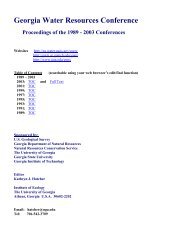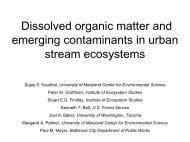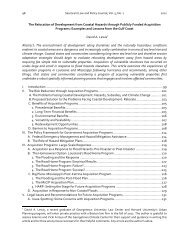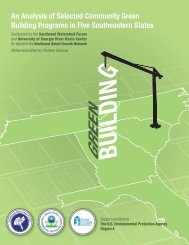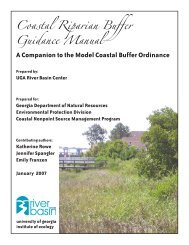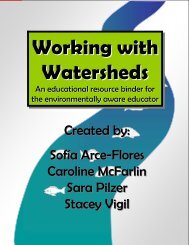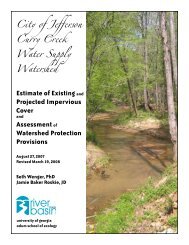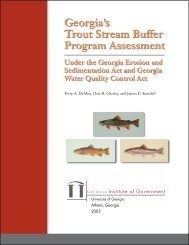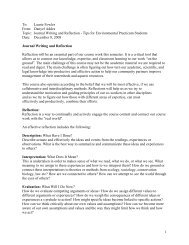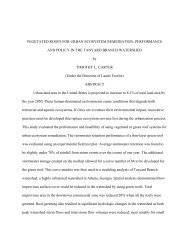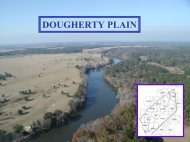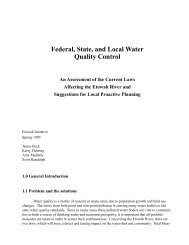The use of constructed wetlands for wastewater treatment
The use of constructed wetlands for wastewater treatment
The use of constructed wetlands for wastewater treatment
You also want an ePaper? Increase the reach of your titles
YUMPU automatically turns print PDFs into web optimized ePapers that Google loves.
2 <strong>The</strong> <strong>use</strong> <strong>of</strong> <strong>constructed</strong> <strong>wetlands</strong> <strong>for</strong> <strong>wastewater</strong> <strong>treatment</strong><br />
Introduction to <strong>constructed</strong> wetland systems<br />
Wetlands, either <strong>constructed</strong> or natural, <strong>of</strong>fer a cheaper and low-cost alternative<br />
technology <strong>for</strong> <strong>wastewater</strong> <strong>treatment</strong>. A <strong>constructed</strong> wetland system that is specifically<br />
engineered <strong>for</strong> water quality improvement as a primary purpose is termed as a<br />
‘Constructed Wetland Treatment System’ (CWTS). In the past, many such systems<br />
were <strong>constructed</strong> to treat low volumes <strong>of</strong> <strong>wastewater</strong> loaded with easily degradable<br />
organic matter <strong>for</strong> isolated populations in urban areas. However, widespread demand<br />
<strong>for</strong> improved receiving water quality, and water reclamation and re<strong>use</strong>, is currently the<br />
driving <strong>for</strong>ce <strong>for</strong> the implementation <strong>of</strong> CWTS all over the world.<br />
Recent concerns over wetland losses have generated a need <strong>for</strong> the creation <strong>of</strong><br />
<strong>wetlands</strong>, which are intended to emulate the functions and values <strong>of</strong> natural <strong>wetlands</strong><br />
that have been destroyed. Natural characteristics are applied to CWTS with emergent<br />
macrophyte stands that duplicate the physical, chemical and biological processes<br />
<strong>of</strong> natural wetland systems. <strong>The</strong> number <strong>of</strong> CWTS in <strong>use</strong> has very much increased<br />
in the past few years. <strong>The</strong> <strong>use</strong> <strong>of</strong> <strong>constructed</strong> <strong>wetlands</strong> in the United States, New<br />
Zealand and Australia is gaining rapid interest. Most <strong>of</strong> these systems cater <strong>for</strong> tertiary<br />
<strong>treatment</strong> from towns and cites. <strong>The</strong>y are larger in size, usually using surface-flow<br />
system to remove low concentration <strong>of</strong> nutrient (N and P) and suspended solids.<br />
However, in European countries, these <strong>constructed</strong> wetland <strong>treatment</strong> systems<br />
are usually <strong>use</strong>d to provide secondary <strong>treatment</strong> <strong>of</strong> domestic sewage <strong>for</strong> village<br />
populations. <strong>The</strong>se <strong>constructed</strong> wetland systems have been seen as an economically<br />
attractive, energy-efficient way <strong>of</strong> providing high standards <strong>of</strong> <strong>wastewater</strong> <strong>treatment</strong>.<br />
Typically, <strong>wetlands</strong> are <strong>constructed</strong> <strong>for</strong> one or more <strong>of</strong> four primary purposes: creation<br />
<strong>of</strong> habitat to compensate <strong>for</strong> natural <strong>wetlands</strong> converted <strong>for</strong> agriculture and urban<br />
development, water quality improvement, flood control, and production <strong>of</strong> food and<br />
fiber (<strong>constructed</strong> aquaculture <strong>wetlands</strong>). In this booklet, the <strong>use</strong>s <strong>of</strong> <strong>constructed</strong><br />
<strong>wetlands</strong> <strong>for</strong> <strong>wastewater</strong> <strong>treatment</strong> or water quality improvement is discussed in detail.<br />
Advantages <strong>of</strong> <strong>constructed</strong> wetland <strong>treatment</strong> systems<br />
Constructed wetland <strong>treatment</strong> systems are a new technology <strong>for</strong> Malaysia. It is a<br />
cheaper alternative <strong>for</strong> <strong>wastewater</strong> <strong>treatment</strong> using local resources. Aesthetically, it<br />
is a more landscaped looking wetland site compared to the conventional <strong>wastewater</strong><br />
<strong>treatment</strong> plants. This system promotes sustainable <strong>use</strong> <strong>of</strong> local resources, which is a<br />
more environment friendly biological <strong>wastewater</strong> <strong>treatment</strong> system.<br />
Constructed <strong>wetlands</strong> can be created at lower costs than other <strong>treatment</strong> options, with<br />
low-technology methods where no new or complex technological tools are needed.<br />
<strong>The</strong> system relies on renewable energy sources such as solar and kinetic energy,<br />
and wetland plants and micro-organisms, which are the active agents in the <strong>treatment</strong><br />
processes.<br />
<strong>The</strong> system can tolerate both great and small volumes <strong>of</strong> water and varying<br />
contaminant levels. <strong>The</strong>se include municipal and domestic <strong>wastewater</strong>, urban storm<br />
run<strong>of</strong>f, agricultural <strong>wastewater</strong>, industrial effluents and polluted surface waters in rivers



